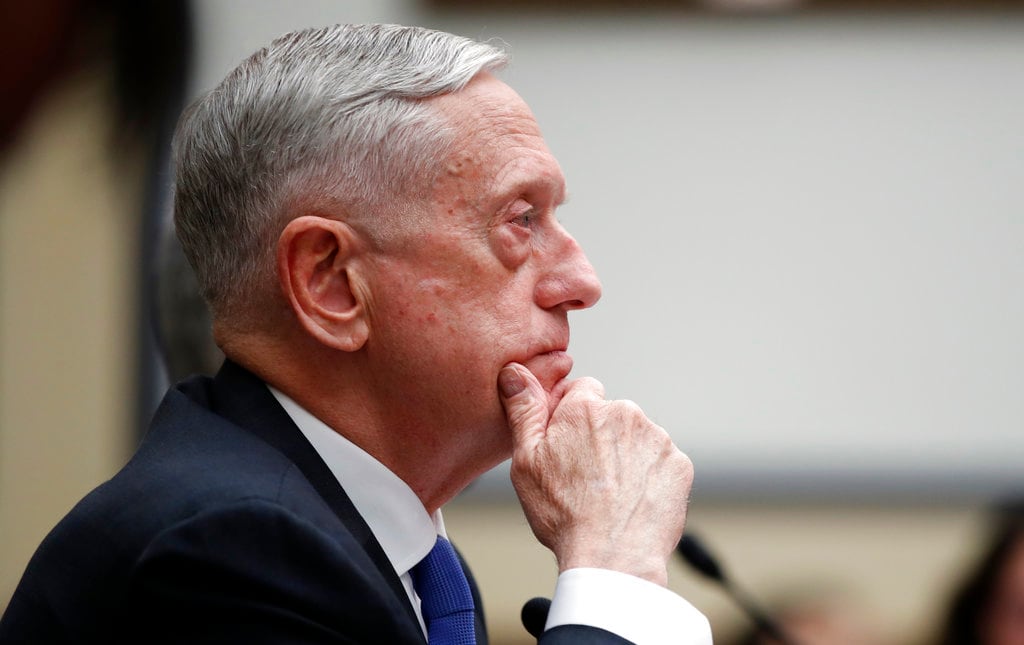WASHINGTON — Defense Secretary Jim Mattis heads to Capitol Hill on Thursday for a review of the Pentagon’s fiscal 2019 budget request.
But he is likely to receive questions on hot-button national security policy issues that have dominated headlines in recent days—some partisan and politically sensitive.
Here’s are five key questions that could impact the nascent 2019 defense policy bill, on which debate will start next month.
Mattis will appear with the chairman of the Joint Chiefs, Marine Corps Gen. Joseph Dunford.
1. Readiness. In the wake of press reports during the 2017 budget season about ground units that could not deploy, aircraft that could not fly and ships that were wearing out, Mattis cautioned military leaders against publicly telegraphing readiness shortfalls. That has prompted several lawmakers to say Pentagon brass must be more transparent about military readiness problems.
The Pentagon owes its record budget increase in part to the argument that depressed funding created a crisis in military readiness. Yet following the deadly crash of an Air Force F-16 outside of Las Vegas on Wednesday—the third U.S. military aircraft crash in two days—Marine Corps Lt. Gen. Kenneth McKenzie, the Joint Staff director, said, “I would reject this as a wave or crisis. Each one is concerning, but mishaps happen in military aviation.”
How ready are the armed services and how honest should DoD be about its flaws?
2. Border deployments. After President Donald Trump failed to convince Mexico or Congress to fund his border wall, he floated the idea of it coming from the military’s hard-won $700 billion fiscal 2018 budget. Instead, Trump announced last week he was sending National Guard troops to the southern border to combat illegal crossings.
House Armed Services Committee Chairman Mac Thornberry said ahead of the announced deployments he does not want to “rob the military,” to beef up border security. “We cannot view the military as a cash cow to meet any national need that comes up because we have real military needs,” Thornberry, R-Texas, told the Times Record News.
The problem, James Stavridis, a retired four-star admiral who commanded American forces in Europe and Latin America, told The New York Times last week: “There is a significant opportunity cost” because troops sent to the border would “miss important training opportunities for their real primary mission — combat.”
So, what exactly are the trade-offs of these border deployments in dollars and readiness?
3. Syria. Trump on Tuesday told television cameras he wanted to “get out,” of Syria just as the U.S. special envoy for fighting the Islamic State insisted “our mission isn’t over.”
Trump’s idea, to withdraw the 2,000 U.S. troops currently in Syria, raised concerns it would leave a power vacuum for Iran and Russia to fill. Since, Trump has bowed to commanders who told him they needed more time to mop up the remaining Islamic State fighters.
Then-Secretary of State Rex Tillerson outlined a new Syria strategy in January — a renewed focus on United Nations-led diplomacy; an emphasis on stabilization in ISIS-liberated areas; and a continued U.S. military presence to prevent the Islamic State from returning — but he’s since been fired.
What are the objectives of U.S. forces in Syria, what’s the plan to accomplish those objectives and what is the timeline for any troop withdrawal?
4. Space force. Trump said he’s for the creation of a separate military ‘space force’ in public remarks that may have been off the cuff. Still, it appeared to contradict the White House, Mattis and Air Force leaders who last year lobbied against carving a Space Corps out of the Air Force when it was proposed in the 2018 National Defense Authorization Act.
“He is bound to get asked about the Department’s position on creating a ‘Space Force’ as Trump has said he wants to do,” said Todd Harrison, a space and budget expert with the Center for Strategic and International Studies. “He better have an answer ready for that other than ‘we’re looking into it.’”
Do you support a new space force?
5. Transgender ban. When Trump announced a new ban on certain transgendered people serving in the military earlier this month, it put the spotlight on Mattis. Advocates regard it as a reversal on his part, pointing to Mattis’ confirmation hearing in 2017, where he suggested he would not roll back Obama-era rules allowing LGBT service members to serve openly.
They also point to reports that Vice President Mike Pence and a group of anti-gay activists played a leading role in drafting the final plan from Mattis on the transgender military ban. (Court fights over the ban are ongoing.)
“Are these reports true? Did Pence overrule what Mattis wanted to recommend?” said Stephen Peters, of the American Military Partner Association. “And if the final plan is actually what Mattis wanted, what changed since his confirmation hearing where he promised not to reverse the previous administration’s policies allowing qualified LGBT Americans to serve in the military?”
Joe Gould was the senior Pentagon reporter for Defense News, covering the intersection of national security policy, politics and the defense industry. He had previously served as Congress reporter.





